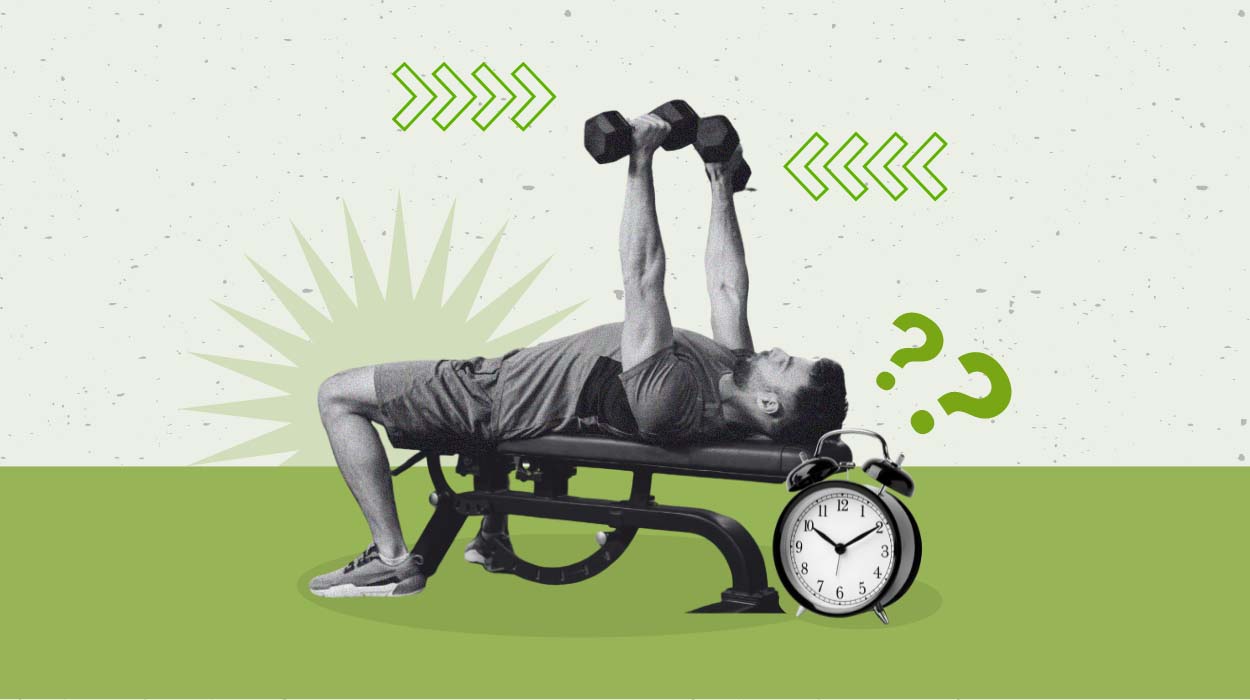
Finding the optimal number of sets per workout is a vital component in crafting a successful training regimen. Whether you aim to build more muscle mass, increase strength, enhance endurance, or simply improve overall fitness, the appropriate number of sets holds the key to unlocking your desired results.
In this article, we will explore how many sets per workout, and discuss various factors to consider when making your decision. We will also provide guidance to help you navigate this aspect of your fitness journey.
How Many Reps And Sets Should I Do In The Workout Routine?
How many sets per muscle group per workout? The number of sets per workout can vary depending on factors such as individual goals, fitness level, and time availability.
When it comes to determining the ideal number of sets for your workouts,[1] it is important to assess your goal including losing fat, muscle gain, endurance, power, or general maintenance. Generally, performing three to five sets per exercise with eight to twelve repetitions will help you achieve one of these listed goals.
To optimize your results, pay attention to your body, gradually increase the intensity, and seek guidance from a fitness professional.
How Many Sets Per Workout Should You Do

Embarking on the journey of determining the ideal sets per workout, we now look into personalized recommendations. Here are a few suggestions:
For Losing Fat
When aiming to lose side fat or fat in general, incorporating both cardiovascular exercises and strength training is beneficial. Each helps to maintain muscle mass while promoting fat loss and improving muscular endurance.
For strength training, the optimal training volume is three to four sets per exercise. Each set should consist of 10 to 15 repetitions using moderate weights. Focus on compound exercises that engage multiple muscle groups, such as squats, deadlifts, and bench presses.
To maintain an elevated heart rate and burn more calories per day, include circuit-style workouts. This involves performing a series of exercises in succession, with little to no rest between sets, allowing you to fatigue your muscles quicker and achieve more optimal results.
For Building Muscle
It is best to use a higher training volume to maximize muscle growth. Perform four to six sets per exercise with each set consisting of eight to twelve repetitions. Focus on compound exercises like chest workout routines to target major muscle groups, and allow adequate rest periods of one to two minutes between sets to optimize muscle recovery and growth.
With the goal of building muscle, it is important to choose a weight that is challenging by the end of the reps and sets. This idea of progressive overload[2] will help you achieve hypertrophy of the muscles you are targeting.
For Endurance Training
When training for endurance, the focus is on improving cardiovascular fitness and stamina. It is recommended to perform higher repetitions with lighter weights and aim for two to three sets per exercise, with each set consisting of 15 to 20 repetitions.
Include exercises that target large muscle groups, such as running, cycling, swimming, or using cardio machines. Incorporate interval training by alternating between periods of high intensity and active recovery. High-intensity intervals last for around 30 seconds to two minutes, while active recovery periods range from one to three minutes.
For Strength And Power
If your goal is to increase overall strength and power,[3] perform three to five sets per exercise, focusing on compound movements such as squats, deadlifts, bench presses, and Olympic lifts. Each set should consist of four to eight repetitions using heavy weights and intensity that challenge your limits.
Allow ample rest periods of two to three minutes between sets to create time to replenish energy and minimize fatigue.
For General Fitness And Maintenance
If you are looking to maintain overall fitness, lose weight in a specific period, or simply improve general health, a moderate approach can be followed. Perform two to three sets per exercise, with each set consisting of eight to twelve repetitions.
Incorporate several exercises that target different muscle groups and include cardiovascular and high-load resistance training. Aim for a well-rounded workout routine that covers strength, cardiovascular fitness, and balance. While the primary goal may not be specifically to build muscle in the same muscle group, this approach can still contribute to some optimal muscle growth.
How Many Sets Per Muscle Group Per Week

The number of sets for a specific muscle group workout can vary due to various factors such as training experience, goals, and individual preferences.
Here is a general guideline for the number of sets per muscle group:
For Beginners
- Chest: 2-3 sets
- Back: 2-3 sets
- Shoulders: 2-3 sets
- Biceps: 2-3 sets
- Triceps: 2-3 sets
- Legs: 2-3 sets
- Abs: 1-2 sets
- Calves: 1-2 sets
For Intermediate/Advanced
- Chest: 3-4 sets
- Back: 3-4 sets
- Shoulders: 3-4 sets
- Biceps: 3-4 sets
- Triceps: 3-4 sets
- Legs: 3-4 sets
- Abs: 2-3 sets
- Calves: 2-3 sets
By simplifying the options, it becomes easier to understand the recommended sets based on your fitness level.
You should adjust the sets according to your individual capabilities and goals. If you need further guidance, consulting with a fitness professional can help you design a tailored workout plan.
Other Tips For Determining How Many Total Sets Per Workout
Here are some additional tips for determining the number of sets per workout.
Training Experience
Beginners should start with fewer sets and gradually increase as they progress. It is appropriate for intermediate and advanced individuals to aim for higher set ranges. If you are unsure about where to start, it is best to meet with a personal trainer, physical therapist, or kinesiology professional for better guidance.
Goals
Your training goals[4] will influence the number of sets you perform. If your goal is to achieve a flat stomach fast, you may opt for workouts that target the abdominal muscles. For muscle hypertrophy (growth), you may incorporate higher set ranges with moderate weights.
Exercise Selection
Different exercises target muscles differently. While compound exercises work for multiple muscle groups simultaneously, isolation exercises like bicep curls or tricep pushdowns isolate specific muscles. Generally, compound exercises require more sets since they engage multiple muscle groups.
Intensity And Volume
Intensity refers to the amount of weight lifted, while volume[5] is the total number of sets and reps performed. If you are performing higher-intensity workouts with heavier weights, you may need fewer sets to allow for sufficient recovery. Alternatively, if you are using lighter weights and focusing on endurance or muscle fatigue, you may perform more sets.
Recovery Ability
Each person’s ability to recover varies. Some individuals may require more time to recover between sets or workouts. If you find that you are constantly fatigued or unable to maintain proper form, consider reducing the number of sets to allow for better recovery.
Time Constraints
If you have limited time for your workouts, you may need to adjust the number of sets accordingly. It is better to prioritize quality over quantity, so focus on performing effective sets rather than rushing through a large number of sets.
Listen To Your Body
Pay attention to how your body responds to your training. If you consistently feel overly fatigued or experience excessive soreness or joint pain, it may be an indication that you are doing too many sets. However, if you feel like you are not challenging yourself enough, you may need to increase the number of sets.
These tips are general guidelines, and individual variations exist. Experimentation and listening to your body are key to finding the optimal number of sets per workout for your specific needs and goals. You should also seek guidance from a fitness professional for advice.
Conclusion
Finding the ideal number of sets per workout is a highly individualized process. To discover how many sets per workout you should include, consider factors like training experience, goals, exercise selection, intensity, recovery ability, and time constraints.
Be sure to listen to your body, and seek guidance from a fitness professional for optimal results. Finding the right balance will help you to optimize your training, promote muscle growth, improve strength, and prevent overtraining.
Frequently Asked Questions
The number of sets you should do per workout depends on factors like your goals, experience level, and exercise selection.
Beginners can start with two to three sets per exercise to allow their muscles to adapt and gradually increase the volume as they progress.
For muscle growth, intermediate and advanced individuals can aim for three to four sets per exercise to provide enough stimulus for muscle adaptation.
If time is a constraint, prioritize quality over quantity. Aim for two to three sets per exercise and focus on compound movements for maximum efficiency.
Resources
- Eneko Baz-Valle, Balsalobre-Fernández, C., Alix-Fages, C. and Santos-Concejero, J. (2022). A Systematic Review of the Effects of Different Resistance Training Volumes on Muscle Hypertrophy. Journal of Human Kinetics, [online] 81, pp.199–210. doi:https://doi.org/10.2478/hukin-2022-0017.
- Plotkin, D., Coleman, M., Derrick Van Every, Maldonado, J., Oberlin, D., Israetel, M., Feather, J., Alto, A., Vigotsky, A.D. and Schoenfeld, B.J. (2022). Progressive overload without progressing load? The effects of load or repetition progression on muscular adaptations. PeerJ, [online] 10, pp.e14142–e14142. doi:https://doi.org/10.7717/peerj.14142.
- Behm, D.G., Young, J.D., Joseph, Reid, J.C., Quigley, P.J., Low, J., Li, Y., Lima, C.D., Hodgson, D.D., Anis Chaouachi, Olaf Prieske and Urs Granacher (2017). Effectiveness of Traditional Strength vs. Power Training on Muscle Strength, Power and Speed with Youth: A Systematic Review and Meta-Analysis. Frontiers in Physiology, [online] 8. doi:https://doi.org/10.3389/fphys.2017.00423.
- Schoenfeld, B.J., Grgic, J., Van, D.W. and Plotkin, D.L. (2021). Loading Recommendations for Muscle Strength, Hypertrophy, and Local Endurance: A Re-Examination of the Repetition Continuum. Sports, [online] 9(2), pp.32–32. doi:https://doi.org/10.3390/sports9020032.
- Eneko Baz-Valle, Maelán Fontes-Villalba and Santos-Concejero, J. (2021). Total Number of Sets as a Training Volume Quantification Method for Muscle Hypertrophy: A Systematic Review. The Journal of Strength and Conditioning Research, [online] 35(3), pp.870–878. doi:https://doi.org/10.1519/jsc.0000000000002776.




